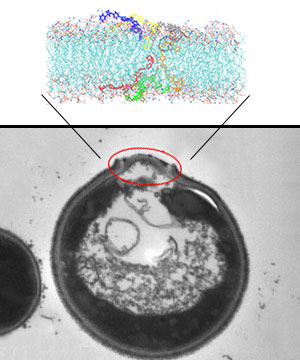| Nov 21, 2012 |
Antibiotics: The plastic approach
|
|
(Nanowerk News) As pathogenic bacteria overcome our current arsenal of antibiotic drugs, new antimicrobial therapies with fresh modes of action are needed. A set of antimicrobials based on synthetic polymers is a promising approach. These experimental therapeutics are highly effective at killing multi-drug-resistant pathogenic bacterial cells, but they have a low selectivity for their target over host tissues and are toxic to red blood cells. Now, an alternative approach to polymer design that overcomes this toxicity, while retaining the high efficacy against pathogens, has been developed by a team led by Yugen Zhang at the A*STAR Institute of Bioengineering and Nanotechnology ("Main-chain imidazolium oligomer material as a selective biomimetic antimicrobial agent").
|
 |
| A microbial membrane (bottom) ruptured by multiple oligomer chains. The image above is a schematic representation of the cell wall (grayish surfaces and an aqua core) breach by the oligomer chains (bolded blue, yellow, gray, orange, green and red).
|
|
Synthetic polymer-based antibiotic drugs were originally inspired by antimicrobial peptides produced by certain species in nature. Importantly, bacteria have proven very slow to develop resistance against these peptides, possibly owing to their particular mode of action: the peptides physically insert into an invading pathogen’s cell membrane, disrupt its structure and kill the cell.
|
|
Although antibiotic drugs based on these natural peptides would be expensive to produce, polymer-based mimics should be low-cost, says Zhang. These synthetic structures copy the ‘amphiphilic’ structure of the natural peptides: they consist of alternating polar and non-polar subunits. The charged, polar units not only help the polymer to penetrate the pathogen’s cell membrane, they can also disrupt host cells.
|
|
In a bid to tune the toxicity of the polymer drugs to avoid killing non-microbial cells, Zhang and his co-workers abandoned the long-chain polymer design. They reasoned that they could improve selectivity by shortening the synthetic chain length, while retaining its highly efficient amphiphilic structure. The short-chain drugs that the researchers produced are known as oligomers.
|
|
In tests against a range of drug-resistant pathogenic bacteria and yeast species, the researchers confirmed that the amphiphilic oligomers retained their broad-spectrum killing action. Electron microscope images showed that, within a few hours of treatment, multiple oligomer strands had penetrated the pathogens’ cell walls, causing them to rupture (see image). Crucially, however, even at high concentrations, these oligomers had minimal effect on red blood cells.
|
|
Having demonstrated in principle that oligomers can improve target selectivity of antimicrobials based on synthetic polymers, Zhang and co-workers plan to refine the idea by further modifying the oligomers’ structures. They believe this will further improve their antimicrobial properties. Other applications besides medical uses are also possible, according to Zhang. “We intend to investigate various applications of these compounds, including their potential as a preservative for cosmetics.”
|

